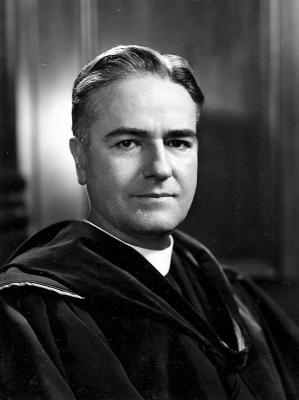President: 1942-1949
Fr. Lawrence Gorman, S.J., served as Georgetown's 41st president from 1942 to 1949. Fr. Gorman's tenure as president featured substantial enrollment growth in the aftermath of World War II and some of the university's first steps toward desegregation and integration.
Early Academic Career
After graduating from Fordham University, Lawrence C. Gorman joined the Society of Jesus in 1920. In 1926, Fr. Gorman came to Georgetown as a Chemistry professor where he remained for three years before returning to finish his studies at Woodstock. Fr. Gorman returned to Georgetown in 1934 as Dean of the College of Arts and Sciences. In December of 1942, Fr. Gorman succeeded Fr. Arthur O’Leary and became the University’s forty-first president.1
World War II
One of Fr. Gorman’s first acts as president was the formation of a war advisory committee aimed at securing some of the new Army Special Training Programs (ASTP) that the United States Army and Navy were implementing in select colleges and universities. In 1943, the University was selected to host an ASTP program focused on engineering, languages, and area studies, a Specialized Assignment and Reclassification (STAR) unit, and as a site for training members of the newly created cadet nursing corps. Members of the nursing corps accounted for 40% of the Nursing School, leading the University to construct Xavier Hall on Prospect Street to accommodate the new nurses in 1944.2
That same year, the University was awarded a $1.4 million federal grant to construct a new hospital on Reservoir Road. In 1945, the federal grant increased to $2.75 million to accommodate the cost of inflation and additions to the hospital. With the construction of a new hospital, the University renewed efforts to reform its medical program which in 1943 saw 11.4% of students fail their medical boards compared to the national average of 2.4%.3
Growth and Expansion
One of Fr. Gorman’s greatest challenges was navigating the University’s rapid growth in the aftermath of World War II. In 1944, University enrollment had dropped to 1,600. By 1946 enrollment had returned to pre-WWII levels with 2,500 students enrolled, and by 1947, enrollment was at an all time high of 5,800 students. The GI Bill facilitated much of this growth, and in 1945, the Veterans Administration established offices in New North. By the spring of 1946, veterans comprised more than four-fifths of students in the SFS. During the 1946-47 school year, 90% of the College’s revenue from tuition, room, and board came from the Veteran Administration’s veterans’ fund.4
This influx of students forced the University to expand its physical facilities, and quickly. The University built two one-story wooden barracks for additional dormitory space and four additional wooden buildings, two of which later became Poulton Hall, served as classroom and office space. Still pressed for dormitory space, the University converted the barn behind Dahlgren Chapel into O’Gara Hall, and the old hospital became another dormitory after the new hospital opened in 1947.5
In 1948, in one of his last acts as president, Fr. Gorman renewed the University’s twenty year effort to build a new gymnasium. Calling it “Georgetown’s greatest physical need of the present,” Fr. Gorman worked closely with the Alumni Association to raise most of the necessary funds.6
Desegregation
Fr. Gorman also oversaw the first steps in integrating the University following inquiries by the provincial superior into the reported segregation of Black patients and a lack of Black doctors and students in the University hospital. Fr. Gorman responded that the University had “no policy in effect to deny admission to any student otherwise qualified, because of race . . . Race or religion is by no means an eliminating factor.” He urged the schools to enroll one Black student for 1948-49 school year, but only the Law School admitted and enrolled four Black students that fall. Twelve Black students were enrolled the following year: nine in the Law School, two in the SFS, and one in the Graduate School.7
Later Years and Legacy
In 1949, Fr. Gorman’s term ended, and he was succeeded by Fr. Hunter Guthrie. After leaving Georgetown, Fr. Gorman served as Vice President and Dean of Studies at the University of Scranton until his death in 1953. When Georgetown expanded the Medical Center campus in 1959, the expansion included the Lawrence C. Gorman Diagnostic and Research Building.8
- 1Georgetown University (Washington, DC), Ye Domesday Booke, 1943, p. 4.
- 2Emmett Curran, Robert. “A History of Georgetown University The Quest for Excellence, 1889-1964.” 2010, p.220-21.
- 3Id. at p.250.
- 4Id. at p.235.
- 5Id. at p.236.
- 6“A Year of Progress.” Georgetown University Alumni Magazine, Vol 1, No. 4, 1948, p.23-24.
- 7Id. at p.238.
- 8Georgetown University (Washington, DC), Ye Domesday Booke, 1949, p. 20.


